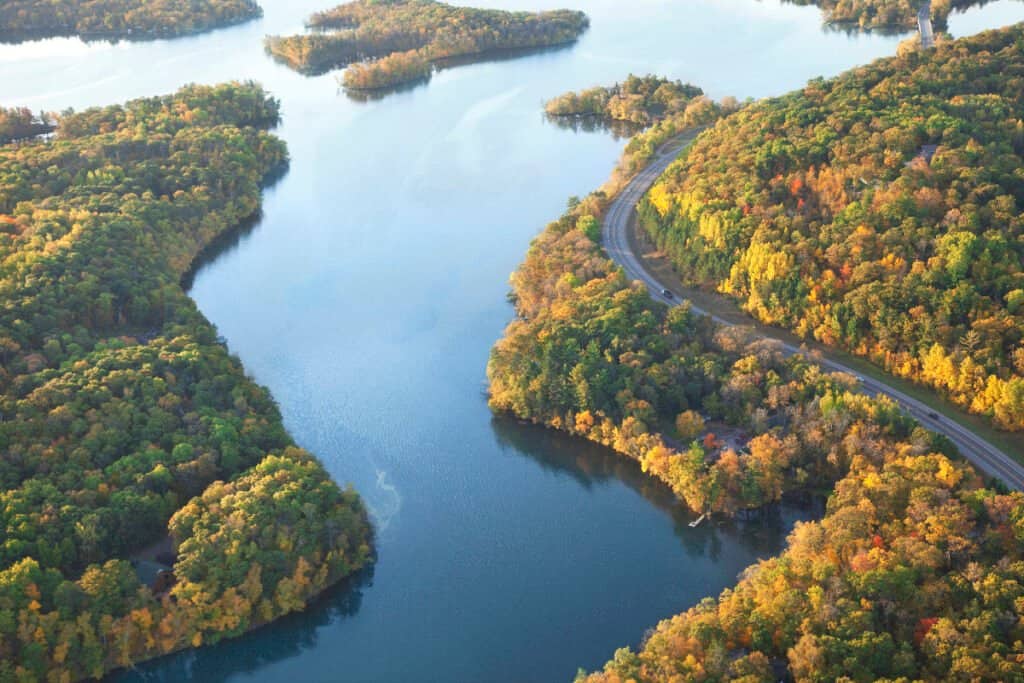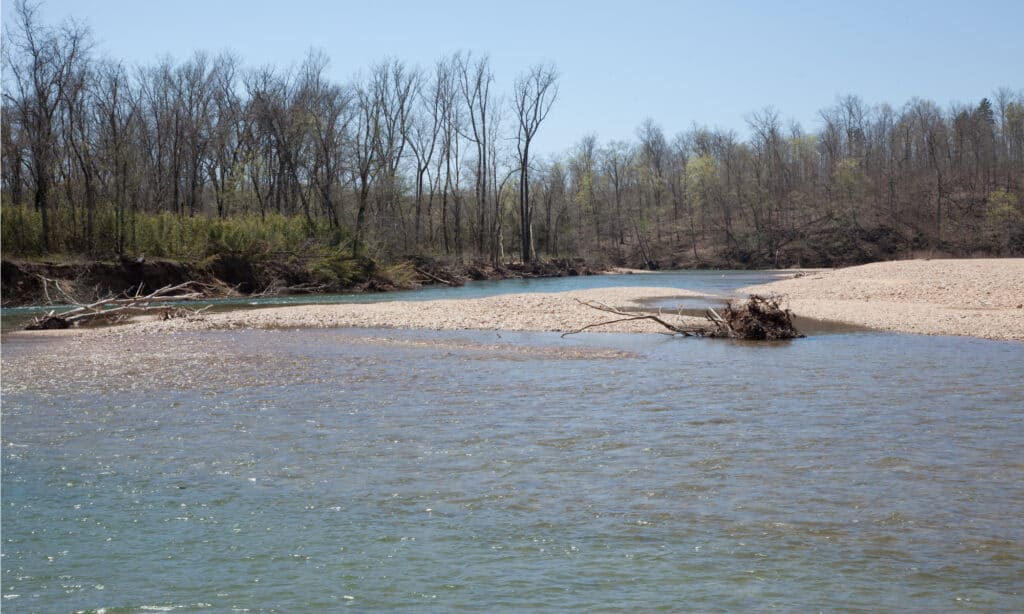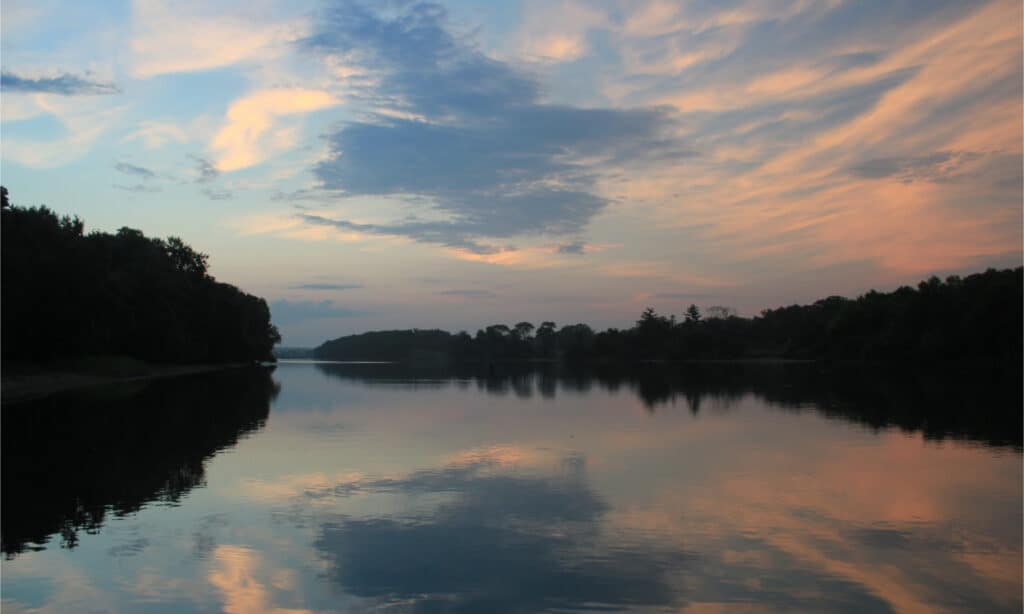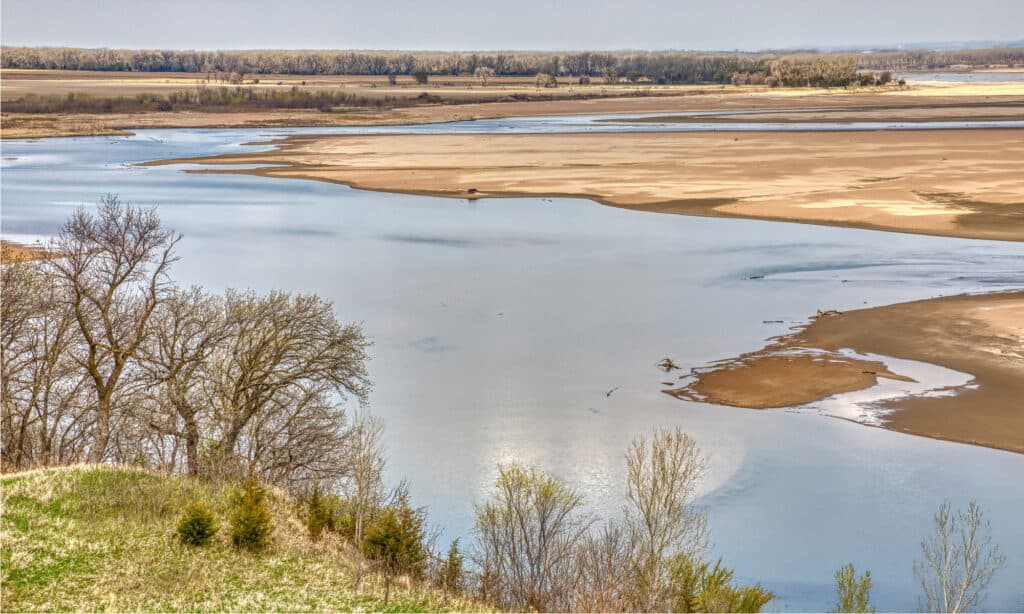4 Major Tributaries of the Mississippi River
@media (min-width: 481px) {
.mobile-top-content {
display: none;
}
}
#mobileTopContentCTACarouselControls { overflow: hidden; text-overflow: ellipsis; white-space: nowrap; }
.mobile-top-content .more { color: #fff; }
.mobile-top-content a { color: #fff; text-decoration: underline; }
.mobile-top-content a:hover { color: #fff; text-decoration: underline; }
@media (max-width: 480px) {
.mobile-top-content {
background-color: #06a10b;
color: #fff;
text-align: center;
/*height: 60px;
padding-top:5px;*/
font-size:80%;
/* display: block; */
margin: 0px -30px;
}
}

iStock.com/Willard
The Mississippi River is 2,340 miles long, stretching from Minnesota to Louisiana. It is the country’s second-longest river. Mississippi’s 250 tributaries drain one-third of the nation’s landmass. A tributary is a freshwater stream that feeds a larger one. The mainstem is the parent river. Confluence is where tributaries meet the main stem.
Any river system contains tributaries, but the Mississippi River is notable for the number and significance of its tributaries, making it one of the most significant river systems in the world. Today, we’ll discuss 4 major Mississippi River tributaries. We’ll look at their length, how much water they flow into the Mississippi, and where their watersheds cross!
1. Big Black River

Scott Sanders/Shutterstock.com
The Big Black River is a major Mississippi tributary. It begins in Webster County at Eupora in north-central Mississippi. It then runs 330 miles (530 km) southwest, merging into the Mississippi River 25 miles (40 km) south of Vicksburg. The river contains a lot of agricultural runoff-caused suspended silt. Therefore, most of its tributaries are silted. These tributaries are muddy, with some being rapid and sandy. Its Basin drains 3,400 square miles and is 50-650 feet above sea level. It is 160 miles long and 25 miles wide. Most of its tiny tributaries flow seasonally in the upper basin. The area is steep, with 56% forested.
2. Ohio River

ESB Professional/Shutterstock.com
The Ohio River is 1,579 km (981 miles) long. It flows southwest from western Pennsylvania to the Mississippi River in southern Illinois, dividing the Midwest and South. It’s the third-largest river in the US by discharge volume and the largest tributary of the north-south Mississippi River, which divides the east and west. It’s North America’s sixth-oldest river. Six states border the river, while 14 states drain into its basin. The basin covers numerous southeastern states through the Tennessee River. Three million people drink from it.
3. Illinois River

sallystap/Shutterstock.com
The Illinois River is a 273-mile (439km) tributary of the Mississippi. The Illinois River drains 28,756.6 square miles in central Illinois. The drainage basin includes parts of Wisconsin, Indiana, and southwestern Michigan. The Illinois River is formed by the Kankakee and Des Plaines rivers in Grundy County, about 16 km southwest of Joliet. Barges convey grain and oil along the waterway. In the summer and early fall, leisure boats cruising the Great Loop use it. The Illinois River is part of the Great Loop, a river route around Eastern North America.
4. Missouri River

Jacob Boomsma/Shutterstock.com
The Missouri River is America’s longest river. It travels east and south for 2,341 miles (3,767 km) until entering the Mississippi River north of St. Louis, Missouri, where it originates in the Eastern Centennial Mountains of southwest Montana. An area of over 500,000 square miles is drained by the river, including sections of ten U.S. states and two Canadian provinces.
Nominally a tributary, the Missouri River is substantially longer than the Mississippi above the confluence. It carries an equivalent volume of water when compared with the Mississippi. By itself, it is not the world’s longest river system, but when coupled with the lower Mississippi River, it becomes so.
In Conclusion
The major tributaries of the Mississippi River are vital habitats that transport a variety of sediment, chemicals, organic matter, and water that sustain a wide range of organisms. Tributaries can introduce both essential ecological components and harmful toxins when they combine with the mainstem. Thus, when rivers are close to developed regions, pollution from their tributaries is magnified, making the water unhealthy for drinking and for habitats. Many types of waste are discharged into the waterways, including residential and industrial waste.
The government is also very important in conserving waterways since river usage and sewage must be regulated by them. The most crucial thing is to raise public awareness of river health and its importance. Rivers will only be cared for with our joint effort. In this critical time, we must unite to protect our rivers. Otherwise, we will not be able to leave a lovely world to future generations unless we act now.
More from A-Z Animals
.more-snake-card-image { max-height:140px !important; }
@media (min-width: 481px) {
.mobile-top-content {
display: none;
}
}
#mobileTopContentCTACarouselControls { overflow: hidden; text-overflow: ellipsis; white-space: nowrap; }
.mobile-top-content .more { color: #fff; }
.mobile-top-content a { color: #fff; text-decoration: underline; }
.mobile-top-content a:hover { color: #fff; text-decoration: underline; }
@media (max-width: 480px) {
.mobile-top-content {
background-color: #06a10b;
color: #fff;
text-align: center;
/*height: 60px;
padding-top:5px;*/
font-size:80%;
/* display: block; */
margin: 0px -30px;
}
}

iStock.com/Willard
The Mississippi River is 2,340 miles long, stretching from Minnesota to Louisiana. It is the country’s second-longest river. Mississippi’s 250 tributaries drain one-third of the nation’s landmass. A tributary is a freshwater stream that feeds a larger one. The mainstem is the parent river. Confluence is where tributaries meet the main stem.
Any river system contains tributaries, but the Mississippi River is notable for the number and significance of its tributaries, making it one of the most significant river systems in the world. Today, we’ll discuss 4 major Mississippi River tributaries. We’ll look at their length, how much water they flow into the Mississippi, and where their watersheds cross!
1. Big Black River

Scott Sanders/Shutterstock.com
The Big Black River is a major Mississippi tributary. It begins in Webster County at Eupora in north-central Mississippi. It then runs 330 miles (530 km) southwest, merging into the Mississippi River 25 miles (40 km) south of Vicksburg. The river contains a lot of agricultural runoff-caused suspended silt. Therefore, most of its tributaries are silted. These tributaries are muddy, with some being rapid and sandy. Its Basin drains 3,400 square miles and is 50-650 feet above sea level. It is 160 miles long and 25 miles wide. Most of its tiny tributaries flow seasonally in the upper basin. The area is steep, with 56% forested.
2. Ohio River

ESB Professional/Shutterstock.com
The Ohio River is 1,579 km (981 miles) long. It flows southwest from western Pennsylvania to the Mississippi River in southern Illinois, dividing the Midwest and South. It’s the third-largest river in the US by discharge volume and the largest tributary of the north-south Mississippi River, which divides the east and west. It’s North America’s sixth-oldest river. Six states border the river, while 14 states drain into its basin. The basin covers numerous southeastern states through the Tennessee River. Three million people drink from it.
3. Illinois River

sallystap/Shutterstock.com
The Illinois River is a 273-mile (439km) tributary of the Mississippi. The Illinois River drains 28,756.6 square miles in central Illinois. The drainage basin includes parts of Wisconsin, Indiana, and southwestern Michigan. The Illinois River is formed by the Kankakee and Des Plaines rivers in Grundy County, about 16 km southwest of Joliet. Barges convey grain and oil along the waterway. In the summer and early fall, leisure boats cruising the Great Loop use it. The Illinois River is part of the Great Loop, a river route around Eastern North America.
4. Missouri River

Jacob Boomsma/Shutterstock.com
The Missouri River is America’s longest river. It travels east and south for 2,341 miles (3,767 km) until entering the Mississippi River north of St. Louis, Missouri, where it originates in the Eastern Centennial Mountains of southwest Montana. An area of over 500,000 square miles is drained by the river, including sections of ten U.S. states and two Canadian provinces.
Nominally a tributary, the Missouri River is substantially longer than the Mississippi above the confluence. It carries an equivalent volume of water when compared with the Mississippi. By itself, it is not the world’s longest river system, but when coupled with the lower Mississippi River, it becomes so.
In Conclusion
The major tributaries of the Mississippi River are vital habitats that transport a variety of sediment, chemicals, organic matter, and water that sustain a wide range of organisms. Tributaries can introduce both essential ecological components and harmful toxins when they combine with the mainstem. Thus, when rivers are close to developed regions, pollution from their tributaries is magnified, making the water unhealthy for drinking and for habitats. Many types of waste are discharged into the waterways, including residential and industrial waste.
The government is also very important in conserving waterways since river usage and sewage must be regulated by them. The most crucial thing is to raise public awareness of river health and its importance. Rivers will only be cared for with our joint effort. In this critical time, we must unite to protect our rivers. Otherwise, we will not be able to leave a lovely world to future generations unless we act now.





